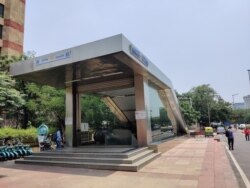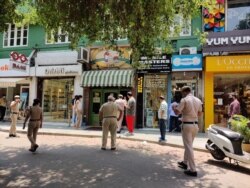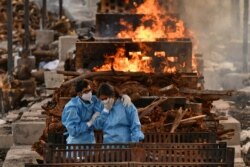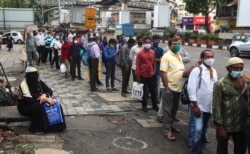Indian capital New Delhi and the financial hub Mumbai reopened businesses two months after a devastating second wave of the coronavirus pandemic shut down much of India. The surge in infections and deaths crushed India’s health care system and dealt a blow to hopes of an economic revival in a country that had largely returned to business as usual earlier this year.
But even as markets lifted shutters and shop owners spruced up their stores, not many ventured out in cities that remain fearful after a more transmissible variant of the coronavirus struck with far greater ferocity than last year.
Besides the country’s two largest cities, restrictions were also eased in several other states that have witnessed declining cases.
“We have to save ourselves from infection but also bring the economy back on track,” Delhi Chief Minister Arvind Kejriwal said on Twitter. In recent days, cases of COVID-19 in the city have plummeted sharply to fewer than 500 in recent days. COVID-19 is the disease caused by the coronavirus.
The reopening of cities is gradual – business hours have been restricted and the metro in the Indian capital will operate with fewer commuters. But the buzz seen outside metro stations earlier this year was missing as people remained cautious about using public transport.
Mumbai’s huge rail network remains shut although offices could open with half their staff. Restaurants, gyms and salons have been allowed to open.
In an address to the nation on Monday, Prime Minister Narendra Modi said that the relaxations should not make people think COVID-19 has ended. “We must continue to follow protocols to win this battle,” he said.
Public health experts have said that the second wave swept through the country after policy makers, top leaders and the public largely abandoned COVID protocols as cases dipped earlier this year.
In Delhi Monday, police patrolled markets to ensure that people adhered to social distancing norms and wore masks.
“Hopefully people will be more vigilant and careful. I think everyone has been affected in one way or the other by COVID, so we cannot revert back to life as normal again,” said Rajni Malhotra, owner of one of the city’s oldest bookstores, Bahrisons Booksellers. “Not all the staff has been called back to work as yet and we will not allow more than five customers. You have to watch your back.”
It is the second time cities like New Delhi and Mumbai are reopening since the pandemic – they opened last summer after a stringent lockdown only to shut down in April as the virus ravaged India once again.
The Indian capital was among the cities worst affected by the second wave – tens of thousands were infected daily for several weeks, critically sick people died outside overwhelmed hospitals or at home waiting for beds, medical oxygen supplies ran scarce and funeral pyres burnt through the night. Fearing the more infectious variant that has driven the second wave, many people did not venture out for weeks.
The health crisis in most cities has eased. Cases of COVID-19 have declined by a quarter from the peak -- compared to more than 400,000 cases a day logged in early May. On Monday, 100,636 new cases were reported nationwide. But while most urban centers are counting fewer infections, the country’s vast rural areas are now epicenters of the pandemic.
The reopening of cities like Delhi and Mumbai, the country’s economic engines, also brought hope to millions of migrant workers who come from rural areas to work in cities.
Twenty-four-year-old Monu Kumar, who returned to his village after the food stall at Delhi airport where he worked shut down, is hoping that he is recalled soon. “After the pandemic Iast year, I only got a job in February and then in just three months everything shut down again,” he said. “It is very hard for us.”
Public health experts caution that even a limited reopening in usually crowded cities poses risks in a country where less than 5 percent of the people are fully vaccinated and have urged authorities to speed up inoculations. But the country is grappling with a severe vaccine shortage.
In his address, Prime Minister Modi said the federal government will provide vaccines free of charge to all adults above 18 – so far free shots have only been given to health care and frontline workers and those above the age of 45. The policy had been widely criticized.
He also said that vaccine supplies will improve as domestic companies ramp up production and the government negotiates with foreign vaccine makers for shots.
The prolonged lockdown in most parts of the country during the last two months will hit prospects of restoring millions of lost jobs and the economy, which shrank by more than 7 percent last year.
A study by Aziz Premji University in India says that the pandemic has pushed 230 million Indians into poverty.















